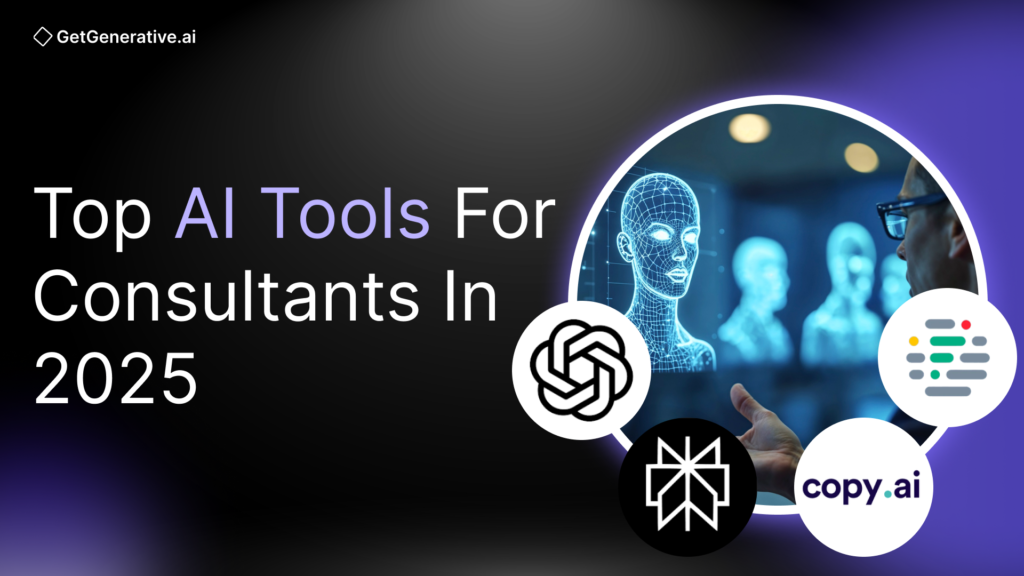Top AI Tools for Consultants in 2025
In 2025, AI has transitioned from being a buzzword to becoming the backbone of modern consulting. Whether you’re a Salesforce consultant drafting implementation roadmaps or a tech strategist decoding market trends, AI tools now serve as critical partners. They automate repetitive tasks, deliver real-time insights, and elevate the quality of outputs — all while reducing time-to-delivery.
For Salesforce and tech consultants in particular, the demands are high: proposal drafting, solution design, coding, communication, and content creation are all part of the game. Thankfully, AI can now accelerate and improve each of these steps.
This guide explores the top AI tools transforming the consulting profession in 2025, complete with real use cases, performance insights, and practical tips.
AI for Research and Knowledge Gathering
1. ChatGPT – The All-Purpose Research and Writing Co-Pilot
Best For: Drafting documents, summarizing reports, answering technical queries, ideation.
Why It Matters:
ChatGPT is the Swiss Army knife of consulting AI. Whether you’re brainstorming strategic recommendations or troubleshooting a Salesforce flow, this tool helps generate high-quality content and solutions quickly. Powered by OpenAI’s GPT-4, ChatGPT supports advanced plugins for real-time data, coding help, or calculations.
Key Benefits:
Summarizes reports and industry papers in minutes
Drafts proposals, slide content, and emails with ease
Assists with technical queries and even code snippets
Acts as a sounding board for ideas and content refinement
Can save consultants up to 30–50% time on initial drafts
Watch Out:
While impressive, ChatGPT doesn’t cite sources by default and may produce hallucinated facts. Always review and validate AI-generated content—especially when working with sensitive client data.
2. Perplexity AI – Research, with References
Best For: Fast fact-checking, data-backed deliverables, summarizing reports with citations.
Why It Matters:
Perplexity. AI combines conversational AI with the power of real-time research. It’s like having a junior analyst who not only summarizes insights but also gives you references you can trust — ideal when writing client reports, decks, or RFPs that require data credibility.
Key Benefits:
Generates accurate answers with cited sources
Summarizes long PDFs, CSVs, and reports
Ideal for competitive analysis, trend forecasts, or data-backed recommendations
Supports multiple AI models (GPT-4, Claude, etc.) in its Pro version
Example:
A Salesforce consultant used Perplexity to analyze CRM market trends and auto-generate a SWOT analysis for a retail industry client’s proposal.
Watch Out:
Sometimes links may lead to general homepages instead of specific references. While it saves time, always double-check key facts before using them in deliverables.
AI for Proposal Development and Workflow Automation
3. GetGenerative.AI – AI-Driven Proposals, Estimates, and Solution Design
Best For: Salesforce and tech consulting firms looking to accelerate proposal creation, SOWs, and discovery documents.
Why It Matters:
Tailored specifically for Salesforce consultants, it helps teams automate pre-sales, project planning, and early-stage solutioning. Instead of manually assembling proposals and timelines, consultants simply input project parameters, and the platform generates full documents, complete with effort estimates and Salesforce-specific best practices.
Key Benefits:
Drafts client-ready proposals and Statements of Work (SOWs) in minutes
Suggests implementation plans and technical solutions based on past project data
Estimates effort and team allocation with AI-driven accuracy
Seamlessly integrates into the Salesforce implementation lifecycle—from pre-sales to go-live
Has helped generate $500M+ worth of proposals for top consulting firms
Real-World Example:
A Salesforce partner used GetGenerative.AI to respond to a complex RFP in under 48 hours—cutting down what would normally be a week-long process. The tool produced a fully structured scope document, effort estimate, and risk matrix, which the team only needed to customize for client specifics.
Watch Out:
AI outputs must be reviewed and customized. The quality of proposals depends on the input detail—vague project descriptions lead to generic drafts. Also, consultants should handle client data carefully, using enterprise-grade security settings.
Why Consultants Choose It:
GetGenerative.AI isn’t just a generic writing tool—it’s trained on Salesforce-specific structures, terminology, and solution patterns. That makes it far more accurate than general AI writers when drafting CRM or cloud implementation documents. For Salesforce consultants, it’s become a key part of the tech stack to reduce non-billable hours and win more deals.
4. Microsoft 365 Copilot – AI Inside Your Workflow
Best For: Automating tasks in Word, Excel, PowerPoint, Outlook, and Teams.
Why It Matters:
Consultants live in Office tools. Microsoft 365 Copilot brings generative AI directly into that environment, enabling professionals to draft emails, analyze spreadsheets, summarize meetings, and create presentations—all within familiar apps.
Key Benefits:
Auto-drafts emails, meeting recaps, and client updates in Outlook
Writes formulas, analyzes budgets, and builds forecasts in Excel
Converts text outlines into presentation decks in PowerPoint
Summarizes Teams meetings and extracts action items
Understands your organizational context, so it tailors outputs to your data
Real-World Example:
A tech consultant preparing for an executive review used Copilot to instantly summarize 12 months of project reports and generate a slide deck, complete with visuals, in under two hours.
Watch Out:
Only available via enterprise Microsoft 365 licenses, which may be cost-prohibitive for small firms. Also, Copilot can occasionally be overly formal or produce generic drafts, requiring refinement for tone or accuracy.
Why Consultants Choose It:
The integration is seamless. No switching tabs, no uploading documents. Copilot works inside your existing workflow—automating dozens of small tasks that used to drain time. It’s a game-changer for consultants who manage multiple deliverables and meetings daily.
5. Loopio – AI for RFP Responses
Best For: Automating responses to RFP questionnaires and security/compliance documents.
Why It Matters:
Loopio and similar platforms (e.g., AutogenAI, Responsive.io) use AI to auto-complete standard RFP responses using a firm’s existing content library. For consulting firms frequently responding to vendor questionnaires, it removes hours of copy-paste work.
Key Benefits:
Auto-fills common answers to RFP questions
Recommends responses based on previous submissions
Maintains brand and compliance consistency
Streamlines collaboration among sales, legal, and delivery teams
Comparison with GetGenerative.AI:
While Loopio excels at structured Q&A formats, GetGenerative.AI stands out for full-document generation (e.g., solution narrative, effort estimates, scope). Many teams use both: Loopio for compliance and vendor forms, GetGenerative for proposals and technical narratives.
Why Consultants Choose It:
When speed and accuracy matter, AI-enabled RFP platforms give consulting firms a competitive edge. They also reduce the risk of errors in repetitive documents and free up experts to focus on tailoring unique content for each opportunity.
AI for Technical Implementation and Development
6. GitHub Copilot – The AI Pair Programmer
Best For: Writing code, building integrations, generating tests, and reviewing logic in real-time.
Why It Matters:
GitHub Copilot has become the go-to AI assistant for developers and technical consultants. Powered by GPT-4, it writes code as you type, making suggestions based on your comments and existing files. For consultants switching between Apex, JavaScript, Python, and SOQL—Copilot drastically reduces time spent on routine coding tasks.
Key Benefits:
Generates functions from comments (e.g., “validate contact email” → full Apex method)
Auto-completes repetitive code, API calls, and test classes
Helps debug, optimize, and explain existing code
Works with major IDEs (especially VS Code, the Salesforce standard)
Boosts development speed by up to 55%, per GitHub and Accenture’s 2024 study
(GitHub Research with Accenture)
Real-World Example:
Salesforce developers use Copilot to generate LWC boilerplate, Apex triggers, and Flow formulas—cutting delivery time for configuration and customizations by hours.
Watch Out:
Copilot is like a supercharged junior dev—it’s fast but not always right. It may produce insecure or buggy code if not reviewed. Consultants should always verify output and conduct code reviews before deployment.
Why Consultants Choose It:
Copilot reduces grunt work and lets tech consultants focus on logic, architecture, and edge cases. Compared to searching Stack Overflow for syntax, Copilot provides contextual code right inside the editor—making development faster and more efficient.
7. Numerous.ai – AI Inside Excel and Google Sheets
Best For: Automating spreadsheet tasks, data cleanup, formula generation, categorization, and forecasting.
Why It Matters:
Consultants spend hours in spreadsheets—whether budgeting, cleaning CRM exports, or analyzing survey results. Numerous.ai brings ChatGPT-like intelligence into Excel and Google Sheets, turning plain English into powerful spreadsheet actions.
Key Benefits:
AI-generated formulas based on natural language
Automatically categorizes, summarizes, and explains data
Performs sentiment analysis, predictions, and outlier detection
Cleans and standardizes data (e.g., dates, text fields) across rows
Works as native formulas (
=NUM.AI(),=NUM.INFER())
Real-World Example:
A consultant used Numerous to classify 5,000 open-text responses from a feedback survey into categories with just one formula—saving days of manual sorting.
Watch Out:
It excels at mid-sized datasets, but for complex data models or enterprise-level BI, you’ll still need advanced tools like Python or Tableau. Also, review formula output—edge cases can occasionally cause errors.
Why Consultants Choose It:
Numerous gives spreadsheet users AI superpowers without leaving Excel. For consultants who live in Sheets or Excel, it’s the quickest way to automate analysis, reporting, and data preparation—especially when deadlines are tight.
Also Read – AI Prompts Cheatsheet To Master Salesforce PreSales Discovery
8. Salesforce Einstein GPT and Other Developer AIs
Notable Mentions:
Salesforce Einstein GPT: Now embedded in Salesforce’s developer tools, it can suggest Flow logic, write Apex snippets, and even generate test classes. Ideal for declarative developers who occasionally need help writing code.
AWS CodeWhisperer: An alternative to Copilot, preferred in AWS-centric environments.
Tabnine & Replit Ghostwriter: Lightweight Copilot alternatives with on-premise or privacy-focused models.
Why It Matters:
Technical consultants now choose AI based on environment and client needs. For instance, Einstein GPT is great for admins or consultants working inside Salesforce Setup, while Copilot remains the leader for custom codebases.
AI for Content Creation and Marketing
9. Copy.ai – AI-Powered Content and Sales Copy
Best For: Marketing content, sales emails, blog posts, LinkedIn updates, newsletters.
Why It Matters:
Copy.ai is a generative writing tool trained to produce engaging, persuasive content tailored to your audience. Consultants use it to create content for client campaigns, personal branding, or firm-level marketing—without relying entirely on copywriters.
Key Benefits:
Templates for blogs, emails, social posts, ads, product pitches
Supports CRM integration to auto-generate client-specific follow-ups
“Brand Voice” feature allows tone customization based on past content
Saves 50–70% of content creation time
Outputs multiple copy variations to choose or refine
Real-World Example:
A Salesforce consultant used Copy.ai to produce LinkedIn content announcing a new service line. The tool suggested headlines, post drafts, and follow-up messages—reducing the writing time from 2 hours to 20 minutes.
Watch Out:
AI-generated content still needs fact-checking and some rewriting. Copy.ai may occasionally produce generic or overly polished text, especially in technical topics—so injecting your voice and expertise is essential.
Why Consultants Choose It:
Unlike generic GPT-based writers, Copy.ai is optimized for sales and marketing use cases. It helps consultants scale communication, pitch services effectively, and produce consistent content—especially useful when juggling multiple clients or campaigns.
10. Frase.io – SEO-Driven Content Research and Optimization
Best For: Creating SEO-optimized blogs, website content, and FAQs.
Why It Matters:
Frase.io is an AI research assistant and content optimizer that helps consultants produce content that ranks well in search engines. It’s perfect for consultants who write blogs, lead magnets, or service pages to generate inbound leads.
Key Benefits:
Generates content briefs by analyzing top-ranking pages
Identifies keyword gaps and competitive topics
Optimizes content in real-time with keyword scoring
Builds Q&A sections for knowledge bases or chatbot training
Saves hours on research and SEO tuning
Real-World Example:
A consultant writing a blog on “AI in CRM” used Frase to instantly identify trending subtopics and questions people were asking online. The final post ranked on page one within weeks, generating organic traffic and client inquiries.
Watch Out:
SEO optimization can sometimes lead to overstuffing or rigid structure—so balance AI suggestions with natural flow. Frase also works best when content is targeted toward ranking, not private/internal use.
Why Consultants Choose It:
Frase ensures your content isn’t just insightful—it’s discoverable. When used properly, it helps consultants create blog posts or landing pages that are both comprehensive and optimized, making it a go-to tool for thought leadership and lead generation.
11. Stockimg.ai – AI-Generated Custom Visuals
Best For: Custom blog images, illustrations, social graphics, report covers.
Why It Matters:
Need a presentation banner, blog thumbnail, or infographic on short notice? Stockimg.ai turns text prompts into professional-grade visuals, cutting dependence on stock sites or design teams.
Key Benefits:
Create custom visuals using AI (flat design, icons, covers, charts)
Licensing included—safe for commercial use
Templates for blog headers, app logos, marketing banners
Edit images post-generation for tweaks (colors, layout)
Real-World Example:
A consulting firm used Stockimg to generate 10 branded visuals for a presentation series—ensuring consistency across decks without hiring a designer.
Watch Out:
AI images can be stylistically inconsistent or need several prompt attempts for perfect results. It’s great for general visuals but less suited for detailed, technical diagrams.
Why Consultants Choose It:
Speed, affordability, and control. Compared to searching stock libraries, Stockimg lets you “create what you need” and edit on the fly. It’s especially useful for consultants who want to maintain a visual brand without constant designer input.
AI for Client Communication and Collaboration
12. Hootsuite Insights (with AI) – Social Listening and Sentiment Analysis
Best For: Monitoring brand mentions, analyzing sentiment, and supporting digital marketing strategies.
Why It Matters:
Hootsuite’s AI-enhanced Insights tool turns social media noise into strategic intelligence. For consultants managing their own brand—or advising clients on customer experience—this tool tracks online conversations, identifies key themes, and surfaces trends in real time.
Key Benefits:
Monitors platforms like LinkedIn, X (formerly Twitter), Instagram, Reddit, and news forums
Uses AI for sentiment detection and brand perception analysis
Recognizes visual logos in images or videos (e.g., retail stores, apps)
Provides engagement and trend forecasts
Generates shareable reports for clients and stakeholders
Real-World Example:
A consultant advising a consumer brand used Hootsuite Insights to track social sentiment after a product launch. The AI detected a spike in negative feedback related to pricing—prompting a swift, targeted response campaign.
Watch Out:
Initial setup requires tuning filters and keywords carefully. While powerful, Hootsuite’s analytics are broader in scope—firms needing deep demographic or psychographic data might also consider platforms like Brandwatch or Sprinklr.
Why Consultants Choose It:
For consultants involved in marketing, PR, or customer experience strategy, social listening is now non-negotiable. Hootsuite’s AI brings clarity and speed, helping consultants back their recommendations with real-time data.
13. Whimsical (with AI) – Visual Collaboration for Planning and Brainstorming
Best For: Process mapping, discovery workshops, solution architecture, and team brainstorming.
Why It Matters:
Whimsical is an intuitive visual collaboration platform now supercharged with AI. Consultants use it to generate flowcharts, mind maps, and wireframes from simple text prompts—making it easier to translate ideas into visuals during client sessions.
Key Benefits:
AI-generated diagrams from natural language prompts
Supports flowcharts, journey maps, org charts, Kanban boards
Real-time collaboration and editing
Integrations with Notion, Jira, Slack, and project tools
Ideal for live workshops, discovery sessions, and stakeholder alignment
Real-World Example:
A Salesforce consultant used Whimsical’s AI to draft a solution architecture from a client’s business process description—saving hours and enabling faster stakeholder buy-in.
Watch Out:
While the AI helps generate first drafts, diagrams usually require refinement for specific scenarios. Also, very large canvases can lag in browser performance during intensive use.
Why Consultants Choose It:
Whimsical lowers the barrier to effective visual thinking. Consultants no longer need to spend hours formatting diagrams. Instead, they can focus on clarity, iteration, and collaboration—especially when working with remote or hybrid teams.
Related Read – Top Salesforce AI Tools – The Ultimate List
14. Otter.ai – AI Meeting Assistant for Transcripts and Summaries
Best For: Recording meetings, generating summaries, and capturing action items.
Why It Matters:
Otter.ai acts as your always-on meeting notetaker. It automatically records Zoom or Teams calls, transcribes discussions in real-time, and extracts decisions, tasks, and key highlights—ensuring that no insight gets lost.
Key Benefits:
Real-time transcription and automatic summaries
Detects speaker names and action items
Searchable transcript archives
Syncs with calendars and meeting invites
Enables post-meeting alignment across stakeholders
Real-World Example:
A consulting team used Otter.ai during a multi-day discovery workshop. Each session’s transcript and summary were instantly available to review, tag, and share—cutting documentation efforts by 70%.
Watch Out:
Accuracy can dip with poor audio or multiple overlapping speakers. Also, consultants must inform meeting participants about recording and transcription for compliance and privacy.
Why Consultants Choose It:
Time is money. With Otter.ai, consultants can stay fully engaged in conversations, knowing the AI is capturing everything. It improves follow-up quality and reduces manual note-taking—critical when juggling multiple clients or complex deliverables.
Conclusion
In 2025, AI tools have transformed the way consultants work, making it easier to automate tasks, enhance decision-making, and streamline workflows. Whether you’re handling complex data, optimizing content for SEO, or managing social media, these AI tools will boost your efficiency and help you stay ahead of the curve.
Curious how consultants are saving hours on proposals and project plans?
With GetGenerative.AI, you can map out scope, effort, and solutions in one place—from first conversation to go-live.
If you’d like to see how it works in real projects, feel free to book a walkthrough at your convenience.




